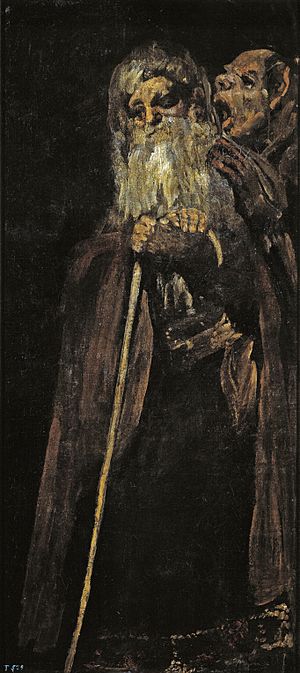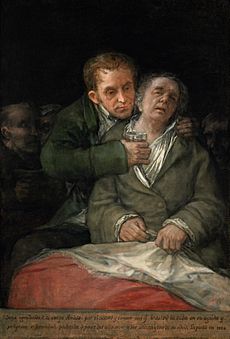Two Old Men facts for kids
Quick facts for kids Two Old Men / Two Monks / An Old Man and a Monk |
|
|---|---|
| Spanish: Dos viejos / Dos frailes / Un viejo y un fraile | |
 |
|
| Artist | Francisco Goya |
| Year | 1819-1823 |
| Medium | Oil mural transferred to canvas |
| Dimensions | 146 cm × 66 cm (57 in × 26 in) |
| Location | Museo del Prado, Madrid |
Two Old Men, also called Two Monks or An Old Man and a Monk, is a famous painting by Francisco Goya. He painted it between 1819 and 1823. This artwork is one of 14 paintings known as the Black Paintings. Goya created these when he was in his seventies. He was going through a difficult time with his health and feelings. He painted these works directly onto the walls of his house, called Quinta del Sordo (which means "The House of the Deaf Man").
Contents
Goya's Life and the Black Paintings
In 1819, Goya bought a house and land near Madrid, Spain. He was 73 years old and decided to live in the countryside. The house was known as the Quinta del Sordo because its previous owner was deaf.
Around this time, Goya became very ill with a mysterious sickness. It might have been a return of an illness he had 25 years earlier. A friend, Dr. Arrieta, helped save his life. Goya painted a portrait of himself with Dr. Arrieta to thank him.
Many people believe Goya's illness led him to create the Black Paintings. These paintings show dark and sometimes scary images. We don't know exactly why Goya made them or what they all mean. Art experts think he probably never meant for anyone else to see them. They were very personal. The painting Two Old Men was likely on the first floor of his house.
What the Painting Shows
In Two Old Men, you see two old figures. They are wearing clothes like those worn by monks. They stand in front of a dark, black background.
The main figure is in the middle. He looks a bit hunched over and has a thoughtful expression. He has a long grey beard and rests his arms on a shepherd's cane. Next to him is another figure. This one looks very strange, almost like an animal or a dead body. This second figure seems to be shouting into the ear of the first man. Some people think this might be a hint about Goya's own deafness. This dark figure makes the painting feel a bit scary. It might show Goya's fears about losing his mind.
The two figures look very different. The bearded man seems calm and sad, resting on his stick. He reminds some experts of wise thinkers painted by Diego Velázquez. The other figure, however, looks monstrous. It is similar to figures Goya drew in his other works, like Caprichos and Disparates. This figure also looks like one in another of Goya's Black Paintings, called Two Old Men Eating. The Black Paintings often show dark images and have a creepy feeling.
How the Painting Was Restored
In 1873, a French banker named Baron Frederic-Emil d'Erlanger bought Goya's house. He paid a lot of money to have the Black Paintings taken off the walls and fixed. Like the other paintings in the series, Two Old Men was moved from the wall to a canvas. This happened between 1873 and 1874. Salvador Martínez Cubells, a curator at the Museo del Prado, watched over the process.
Baron Émile d'Erlanger gave the paintings to the Spanish government in 1881. Today, you can see them at the Museo del Prado in Madrid. Two Old Men was in bad shape and needed a lot of repair work. Old photos show that before it was fixed, there was a big crack in the plaster on the top right side.
During the restoration, some changes were made to the painting. For example, Cubells added brighter parts to the main figure's forehead, beard, and hands. This made the painting have more contrast, but some people think it lost some of its original quality. The main figure's dark and serious face became more thoughtful after the restoration. The shapes of the figures, especially their arms, shoulders, and hands, were also changed. The face of the second figure was changed quite a bit too, and some of the shadows were damaged. Cubells used strong black lines and simple outlines, which made the painting lose some of Goya's amazing details and how he used dark colors to create shapes.
See also
 In Spanish: Dos viejos para niños
In Spanish: Dos viejos para niños


